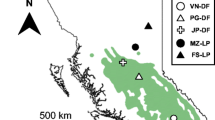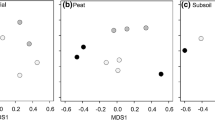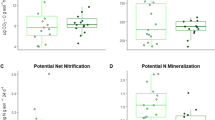Abstract
Ectomycorrhizal fungal (EMF) communities vary among microhabitats, supporting a dominant role for deterministic processes in EMF community assemblage. EMF communities also differ between forest and clearcut environments, responding to this disturbance in a directional manner over time by returning to the species composition of the original forest. Accordingly, we examined EMF community composition on roots of spruce seedlings planted in three different microhabitats in forest and clearcut plots: decayed wood, mineral soil adjacent to downed wood, or control mineral soil, to determine the effect of retained downed wood on EMF communities over the medium and long term. If downed and decayed wood provide refuge habitat distinct from that of mineral soil, we would expect EMF communities on seedlings in woody habitats in clearcuts to be similar to those on seedlings planted in the adjacent forest. As expected, we found EMF species richness to be higher in forests than clearcuts (P ≤ 0.01), even though soil nutrient status did not differ greatly between the two plot types (P ≥ 0.05). Communities on forest seedlings were dominated by Tylospora spp., whereas those in clearcuts were dominated by Amphinema byssoides and Thelephora terrestris. Surprisingly, while substrate conditions varied among microsites (P ≤ 0.03), especially between decayed wood and mineral soil, EMF communities were not distinctly different among microhabitats. Our data suggest that niche partitioning by substrate does not occur among EMF species on very young seedlings in high elevation spruce-fir forests. Further, dispersal limitations shape EMF community assembly in clearcuts in these forests.



Similar content being viewed by others
References
Agerer R (1987–2002) Colour atlas of ectomycorrhizae. Einhorn Eduard Dietenberger, Schwäbisch Gmünd
Altschul SF, Madden TL, Schaffer AA, Zhang JH, Zhang Z, Miller W, Lipman DJ (1997) Gapped BLAST and PSI-BLAST—a new generation of protein database search programs. Nucleic Acids Res 25:3389–3402. doi:10.1093/nar/25.17.3389
Anderson MJ (2005) PERMANOVA: a FORTRAN computer program for permutational multivariate analysis of variance. University of Auckland, Department of Statistics, New Zealand
Baier R, Ingenhaag J, Blaschke H, Göttlein A, Agerer R (2006) Vertical distribution of an ectomycorrhizal community in upper soil horizons of a young Norway spruce (Piceaabies [L.] Karst.) stand of the Bavarian limestone Alps. Mycorrhiza1 6:197–206
Barker JS, Simard SW, Jones MD, Durall DM (2013) Ectomycorrhizal fungal community assembly on regenerating Douglas-fir after wildfire and clearcut harvesting. Oecologia. doi: 10.1007/s00442-012-2562-y
Beiler KJ, Durall DM, Simard SW, Maxwell SA, Kretzer AM (2010) Architecture of the wood-wide web: rhizopogon species genets link multiple Douglas-fir cohorts. New Phytol 185:543–553. doi:10.1111/j.1469-8137.2009.03069.x
Berg Å, Ehnström B, Gustafsson L, Hallingbäck T, Jonsell M, Weslien J (1994) Threatened plant, animal, and fungus species in Swedish forests: distribution and habitat associations. Conserv Biol 8:718–731. doi:10.1046/j.1523-1739.1994.08030718.x
Blaalid R, Carlsen T, Kumar S, Halvorsen R, Ugland KI, Fontana G, Kauserud H (2012) Changes in the root-associated fungal communities along a primary succession gradient analysed by 454 pyrosequencing. Mol Ecol 21:1897–1908. doi:10.1111/j.1365-294X.2011.05214.x
Brewer JS, Bertz CA, Cannon JB, Chesser JD, Maynard EE (2012) Do natural disturbances or the forestry practices that follow them convert forests to early- successional communities? Ecol Appl 22:442–458. doi:10.1890/11-0386.1
Bruns TD (1995) Thoughts on the processes that maintain local species diversity of ectomycorrhizal fungi. Plant Soil 170:63–73. doi:10.1007/BF02183055
Buée M, Reich M, Murat C, Morin E, Nilsson RH, Uroz S, Martin F (2009) 454 Pyrosequencing analyses of forest soils reveal an unexpectedly high fungal diversity. New Phytol 184:449–456. doi:10.1111/j.1469-8137.2009.03003.x
Bunnell F, Houde I (2010) Down wood and biodiversity-implications to forest practices. Environ Rev 18:397–421. doi:10.1139/A10-019
Chase JM, Myers JA (2011) Disentangling the importance of ecological niches from stochastic processes across scales. Philos Trans R Soc Lond B 366:2351–2363. doi:10.1098/rstb.2011.0063
Christy EJ, Sollins P, Trappe JM (1982) First-year survival of Tsuga heterophylla without mycorrhizae and subsequent ectomycorrhizal development on decaying logs and mineral soil. Can J Bot 60:1601–1605. doi:10.1139/b82-206
Colwell RK (2009) EstimateS: Version 8.2. Statistical estimation of species richness and shared species from samples. http://purl.oclc.org/estimates
Craig VJ, Klenner W, Feller MC, Sullivan TP (2006) Relationships between deer mice and downed wood in managed forests of southern British Columbia. Can J For Res 36:2189–2203. doi:10.1139/x06-118
Deacon JW, Fleming LV (1992) Specificity phenomena in mycorrhizal symbiosis: community-ecological consequences and practical implications. In: Allen MF (ed) Mycorrhizal functioning: an integrative plant-fungal process. Chapman & Hall, New York, pp 249–300
Dickie IA, Reich PB (2005) Ectomycorrhizal fungal communities at forest edges. J Ecol 93:244–255. doi:10.1111/j.1365-2745.2005.00977.x
Dickie IA, Richardson SJ, Wiser SK (2009) Ectomycorrhizal fungal communities and soil chemistry in harvested and unharvested temperate Nothofagus rainforests. Can J For Res 39:1069–1079. doi:10.1139/X09-036
Ding Q, Liang Y, Legendre P, X-h He, Pei K-q Du, X-j Ma K-p (2011) Diversity and composition of ectomycorrhizal community on seedling roots: the role of host preference and soil origin. Mycorrhiza 12:669–680. doi:10.1007/s00572-011-0374-2
Druebert C, Lang C, Valtanen K, Polle A (2009) Beech carbon productivity as driver of ectomycorrhizal abundance and diversity. Plant Cell Env 32:992–1003. doi:10.1111/j.1365-3040.2009.01983.x
Dufrêne M, Legendre P (1997) Species assemblages and indicator species: the need for a flexible asymmetrical approach. Ecol Monogr 67:345–366
Elliott JC, Smith JE, Cromack K Jr, Chen H, McKay D (2007) Chemistry and ectomycorrhizal communities of coarse wood in young and old-growth forests in the Cascade Range of Oregon. Can J For Res 37:2041–2051. doi:10.1139/X07-014
Flynn D, Newton AC, Ingleby K (1998) Ectomycorrhizal colonization of Sitka spruce (Picea sitchensis (Bong.) Carr) seedlings in a Scottish plantation forest. Mycorrhiza 7:313–317. doi:10.1007/s005720050198
Gardes M, Bruns TD (1993) ITS primers with enhanced specificity for Basidiomycetes—application to the identification of mycorrhizae and rusts. Mol Ecol 2:113–118. doi:10.1111/j.1365-294X.1993.tb00005.x
Gibson F, Deacon JW (1988) Experimental study of establishment of ectomycorrhizas in different regions of birch root systems. Trans Br Mycol Soc 91:239–251
Gibson F, Deacon JW (1990) Establishment of ectomycorrhizas in aseptic culture: effects of glucose, nitrogen and phosphorus in relation to successions. Mycol Res 94:166–172. doi:10.1016/S0953-7562(09)80608-4
Goodman DM, Trofymow JA (1998) Distribution of ectomycorrhizas in microhabitats in mature and old-growth stands of Douglas-fir on southeastern Vancouver Island. Soil Biol Biochem 30:2127–2138. doi:10.1016/S0038-0717(98)00094-7
Goodman DM, Durall DM, Trofymow JA, Berch SM (1996) A manual of concise descriptions of North American Ectomycorrhizae. Mycologue, Sydney, pp 3A1–3A5
Grime JP (1977) Evidence for the existence of three primary strategies in plants and its relevance to ecological and evolutionary theory. Am Nat 111:1169–1194
Hagerman SH, Durall DM (2004) Ectomycorrhizal colonization of greenhouse-grown Douglas-fir (Pseudotsuga menziesii) seedling by inoculum associated with the roots of refuge plants sampled from a Douglas-fir forest in the southern interior of British Columbia. Can J Bot 82:742–751. doi:10.1139/b04-047
Hagerman SH, Jones MD, Bradfield GE, Gillespie M, Durall DM (1999) Effects of clear- cut logging on the diversity and persistence of ectomycorrhizas at a subalpine forest. Can J For Res 29:124–134. doi:10.1139/x98-186
Hannam KD, Prescott CE (2003) Soluble organic nitrogen in forests and adjacent clearcuts in British Columbia, Canada. Can J For Res 33:1709–1718. doi:10.1139/x03-091
Harvey AE, Larsen MJ, Jurgensen MF (1979) Comparative distribution of ectomycorrhizae in soils of three western Montana forest habitat types. For Sci 25:350–358
Hollstedt C, Vyse A. (1997) Sicamous Creek Silvicultural Systems Project: Workshop Proceedings April 24–25, 1996. Work Pap 24/1997. Res Br BC Min For, Victoria, B.C., Canada
Iwánski M, Rudawska M (2007) Ectomycorrhizal colonization of naturally regenerating Pinus sylvestris L. seedlings growing in micro-habitats in boreal forests. Mycorrhiza 17:461–467. doi:10.1007/s00572-007-0132-7
Izzo A, Nguyen DT, Bruns TD (2006) Spatial structure and richness of ectomycorrhizal fungi colonizing bioassay seedlings from resistant propagules in a Sierra Nevada forest: comparisons using two hosts that exhibit different seedling establishment patterns. Mycologia 98:374–383. doi:10.3852/mycologia.98.3.374
Jones MD, Hagerman SH, Gillespie M (2002) Ectomycorrhizal colonization and richness of previously colonized, containerized Picea engelmannii does not vary across clearcuts when planted in mechanically site-prepared mounds. Can J For Res 32:1425–1433. doi:10.1139/x02-069
Jones MD, Durall DM, Cairney JGW (2003) Ectomycorrhizal fungal communities in young stands regenerating after clearcut logging. New Phytol 157:399–422. doi:10.1046/j.1469-8137.2003.00698.x
Jones MD, Grenon F, Peat H, Fitzgerald M, Holt L, Philip LJ, Bradley R (2009) Differences in 15 N uptake among spruce seedlings colonized by three pioneer ectomycorrhizal fungi in the field. Fungal Ecol 2:110–120. doi:10.1016/j.funeco.2009.02.002
Jonsson L, Dahlberg A, Nilsson M-C, Kårén O, Zackrisson O (1999) Continuity of ectomycorrhizal fungi in self-regenerating boreal Pinus sylvestris forests studied by comparing mycobiont diversity on seedlings and mature trees. New Phytol 142:151–162. doi:10.1046/j.1469-8137.1999.00383.x
Jumpponen A (2003) Soil fungal community assembly in a primary successional glacier forefront ecosystem as inferred from rDNA sequence analyses. New Phytol 158:569–578. doi:10.1046/j.1469-8137.2003.00767.x
Jumpponen A, Jones KL (2009) Massively parallel 454 sequencing indicates hyperdiverse fungal communities in temperate Quercus macrocarpa phyllosphere. New Phytol 184:438–448. doi:10.1111/j.1469-8137.2009.02990.x
Katoh K, Misawa K, Kuma K, Miyata T (2002) Mafft: a novel method for rapid multiple sequence alignment based on fast fourier transform. Nucleic Acids Res 30:3059–3066. doi:10.1093/nar/gkf436
Kennedy P, Higgins LM, Rogers RH, Weber MG (2011) Colonization-competition tradeoffs as a mechanism driving successional dynamics in ectomycorrhizal fungal communities. PLoS ONE 6:1–10. doi:10.1371/journal.pone.0025126
Kernaghan G, Khasa D (2003) Mycorrhizal and root endophytic fungi of containerized Picea glauca seedlings assessed by DNA sequence analysis. Microb Ecol 45:128–136. doi:10.1007/s00248-002-1024-1
Koide RT, Fernandez C, Petprakob K (2011) General principles in the community ecology of ectomycorrhizal fungi. Ann For Sci 68:45–55. doi:10.1007/s13595-010-0006-6
Kranabetter JM, Friesen J (2002) Ectomycorrhizal community structure on western hemlock (Tsuga heterophylla) seedlings transplanted from forests into openings. Can J Bot 80:861–868. doi:10.1139/b02-071
Laiho R, Prescott CE (2004) Decay and nutrient dynamics of coarse woody debris in northern coniferous forests: a synthesis. Can J For Res 34:763–777. doi:10.1139/x03-241
Lekberg Y, Koide RT, Rohr JR, Aldrich-Wolfe L, Morton JB (2007) Role of niche restrictions and dispersal in the composition of arbuscular mycorrhizal fungal communities. J Ecol 95:95–105. doi:10.1111/j.1365-2745.2006.01193.x
McCune B, Mefford MJ (1999) PC-Ord. Multivariate analysis of ecological data, Version 5.0. MJM Software Design, Gleneden Beach
McKinnon LM, Mitchell AK (2003) Photoprotection, not increased growth, characterizes the response of Engelmann spruce (Picea engelmannii) seedlings to high light, even when resources are plentiful. New Phytol 160:69–79. doi:10.1046/j.1469-8137.2003.00854.x
Molina R, Horton TR, Trappe JM, Marcot BG (2010) Addressing uncertainty: how to conserve and manage rare or little-known fungi. Fungal Ecol 4:134–146. doi:10.1016/j.funeco.2010.06.003
Nara K (2005) Ectomycorrhizal networks and seedling establishment during early primary succession. New Phytol 169:169–178. doi:10.1111/j.1469-8137.2005.01545.x
Nilsson RH, Bok G, Ryberg M, Kristiansson E, Hallenberg N (2009) A software pipeline for processing and identification of fungal ITS sequences. Source Code Biol Med 4:1. doi:10.1186/1751-0473-4-1
Nilsson RH, Veldre V, Hartmann M, Unterseher M, Amend A, Bergsten J, Kristiansson E, Ryberg M, Jumpponen A, Abarenkov K (2010) An open source software package for automated extraction of ITS1 and ITS2 from fungal ITS sequences for use in high-throughput community assays and molecular ecology. Fungal Ecol 3:284–287. doi:10.1016/j.funeco.2010.05.002
Oksanen J, Blanchet FG, Kindt R, Legendre P, Minchin PR, O’Hara RB, Simpson GL, Solymos P, Henry M, Stevens H, Wagner H (2012) vegan: community ecology package. R package version 2.1 http://R-Forge.R-project.org/projects/vegan/
Palfner G, Cassanova-Katny MA, Read DJ (2005) The mycorrhizal community in a forest chronosequence of Sitka spruce (Picea sitchensis (Bong. (Carr) in Northern England. Mycorrhiza 15:571–579. doi:10.1007/s00572-005-0364-3
Parrent JL, Peay K, Arnold AE, Comas LH, Avis P, Tuininga A (2010) Moving from pattern to process in fungal symbioses: linking functional traits, community ecology and phylogenetics. New Phytol 185:882–886. doi:10.1111/j.1469-8137.2010.03190.x
Peay KG, Garbelotto M, Bruns TD (2010) Evidence of dispersal limitation in soil microorganisms: isolation reduces species richness on mycorrhizal tree islands. Ecology 91:3631–3640. doi:10.1890/09-2237.1
Preston CM, Trofymow JA, Nault JR (2012) Decomposition and change in N and organic composition of small-diameter Douglas-fir woody debris over 23 years. Can J For Res 42:1153–1167. doi:10.1139/x2012-076
Queloz V, Sieber TN, Holenrieder O, McDonald BA, Grünig CR (2011) No biogeographical pattern for a root-associated fungal species complex. Glob Ecol Biogeogr 20:160–169. doi:10.1111/j.1466-8238.2010.00589.x
R Development Core Team (2012) R: A language and environment for statistical computing. R Foundation for statistical computing, Vienna, Austria. ISBN 3-900051-07-0, URL http://www.R-project.org/
Rudawska M, Leski T, Trocha LK, Gornowicz R (2006) Ectomycorrhizal status of Norway spruce seedlings from bare-root forest nurseries. For Ecol Manag 236:375–384. doi:10.1016/j.foreco.2006.09.066
Schloss PD, Westcott SL, Ryabin T, Hall JR, Hartmann M, Hollister EB, Lesniewski RA, Oakley BB, Parks DH, Robinson CJ, Sahl JW, Stres B, Thallinger GG, Van Horn DJ, Weber CF (2009) Introducing MOTHUR: open-source, platform- independent, community-supported software for describing and comparing microbial communities. Appl Environ Microbiol 75:7537–7541. doi:10.1128/AEM.01541-09
Shortle WC, Smith KT, Jellison J, Schilling JS (2012) Potential of decaying wood to restore root- available base cations in depleted forest soils. Can J For Res 42:1015–1024. doi:10.1139/x2012-056
Simard SW, Perry DA, Smith JE, Molina R (1997) Effects of soil trenching on occurrence of ectomycorrhizae on Pseudotsuga menziesii seedlings grown in mature forests of Betula papyrifera and Pseudotsuga menziesii. New Phytol 136:327–340. doi:10.1046/j.1469-8137.1997.00731.x
Smith JE, Molina R, Huso MMP, Larsen MJ (2000) Occurrence of Piloderma fallax in young, rotation-age, and old-growth stands of Douglas-fir (Pseudotsuga menziesii) in the Cascade Range of Oregon, U.S.A. Can J Bot 78:995–1001. doi:10.1139/b00-085
Taylor DL, Bruns TD (1999) Community structure of ectomycorrhizal fungi in a Pinus muricata forest: minimal overlap between the mature forest and resistant propagule communities. Mol Ecol 8:1837–1850. doi:10.1046/j.1365-294x.1999.00773.x
Tedersoo L, Kõljalg U, Hallenberg N, Larsson K-H (2003) Fine scale distribution of ectomycorrhizal fungi and roots across substrate layers including coarse woody debris in a mixed forest. New Phytol 159:153–165. doi:10.1046/j.1469-8137.2003.00792.x
Tedersoo L, Suvi T, Jairus T, Kõljalg U (2008) Forest microsite effects on community composition of ectomycorrhizal fungi on seedling of Picea abies and Betula pendula. Environ Microbiol 10:1189–1201. doi:10.1111/j.1462-2920.2007.01535.x
Tedersoo L, Nilsson RH, Abarenkov K, Jairus T, Sadam A, Saar I, Bahram M, Bechem E, Chuyong G, Kõljalg U (2010) 454 Pyrosequencing and Sanger sequencing of tropical mycorrhizal fungi provide similar results but reveal substantial methodological bias. New Phytol 188:291–301. doi:10.1111/j.1469-8137.2010.03373.x
Walker JKM, Ward V, Paterson C, Jones MD (2012) Coarse woody debris retention in subalpine clearcuts affects ectomycorrhizal root tip community structure within fifteen years of harvest. J Appl Soil Ecol 60:5–15. doi:10.1016/j.apsoil.2012.02.017
Wall A (2008) Effect of removal of logging residue on nutrient leach and nutrient pools in the soil after clearcutting in a Norway spruce stand. For Ecol Manag 3256:1372–1383
Wallander H, Johansson U, Sterkenburg E, Durling MB, Lindahl BD (2010) Production of ectomycorrhizal mycelium peaks during canopy closure in Norway spruce forests. New Phytol 187:1124–1134. doi:10.1111/j.1469-8137.2010.03324.x
White TJ, Bruns T, Lee S, Taylor JW (1990) Amplification and direct sequencing of fungal ribosomal RNA genes for phylogenetics. In: Innis MA, Gelfand DH, Sninsky JJ, White TJ (eds) PCR protocols: a guide to methods and applications. Academic, New York, pp 315–322
Wu BY, Nara K, Hogetsu T (2001) Can C-14 labeled photosynthetic products move between Pinus densiflora seedlings linked by ectomycorrhizal mycelia? New Phytol 149:137–146. doi:10.1046/j.1469-8137.2001.00010.x
Acknowledgments
Funding for this project was provided by a Discovery Grant from the Natural Sciences and Engineering Research Council, and by the Forest Science Program of the British Columbia Forest Investment Account to M.J. J.W. acknowledges support from UBC Okanagan and the Province of BC for scholarships. We thank Alan Vyse for safe access to the field site, MaryAnn Olson and Fawn Ross for extensive fieldwork, and Valerie Ward for unsurpassed assistance in the field and laboratory. This manuscript was greatly improved with the help of constructive comments from two anonymous reviewers.
Conflict of interest
The authors declare that no financial conflict of interest exists.
Author information
Authors and Affiliations
Corresponding author
Additional information
Communicated by Hakan Wallander.
Electronic supplementary material
Below is the link to the electronic supplementary material.
Rights and permissions
About this article
Cite this article
Walker, J.K.M., Jones, M.D. Little evidence for niche partitioning among ectomycorrhizal fungi on spruce seedlings planted in decayed wood versus mineral soil microsites. Oecologia 173, 1499–1511 (2013). https://doi.org/10.1007/s00442-013-2713-9
Received:
Accepted:
Published:
Issue Date:
DOI: https://doi.org/10.1007/s00442-013-2713-9




